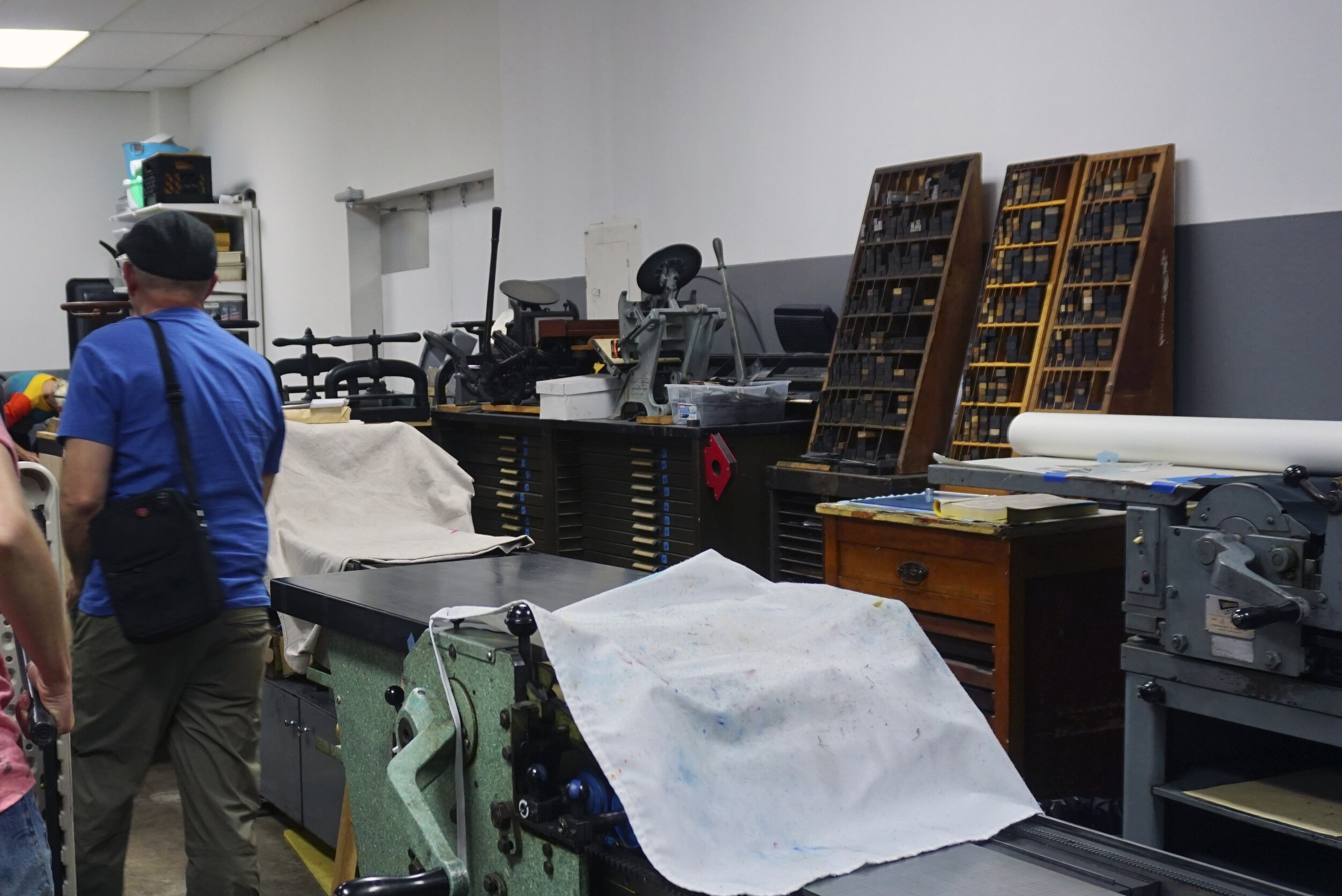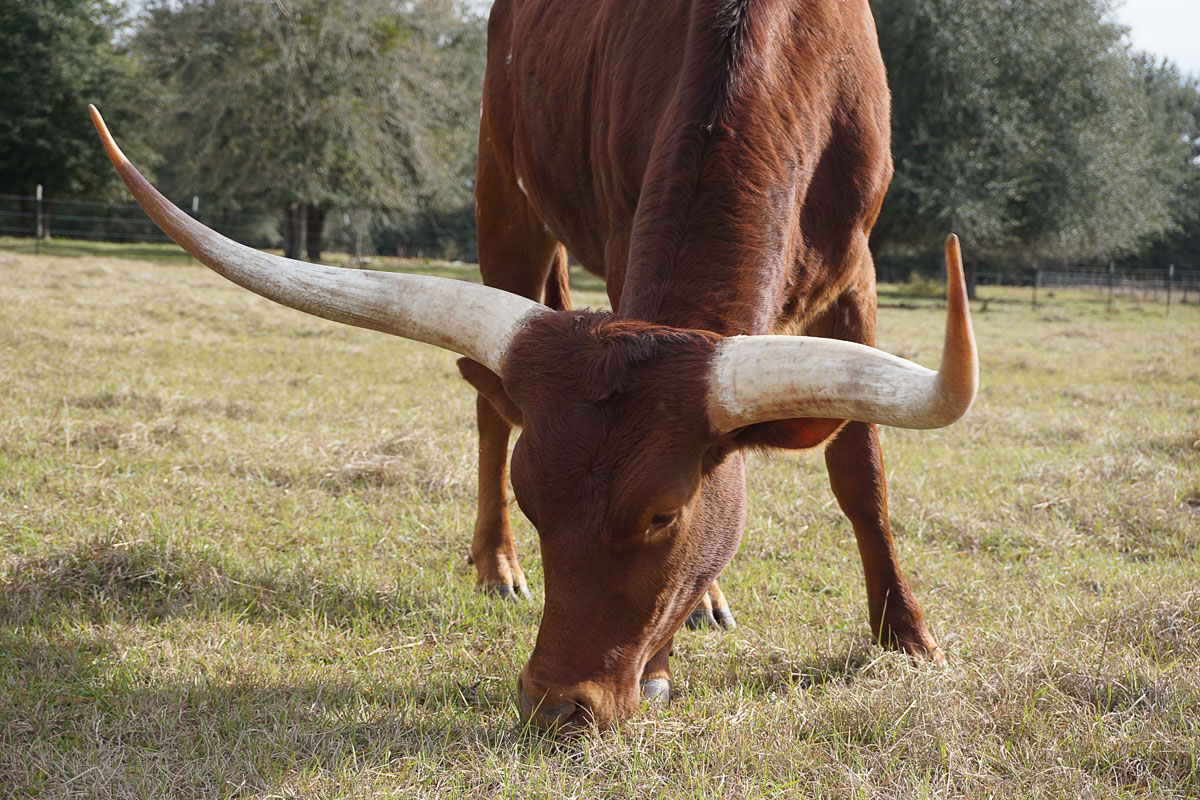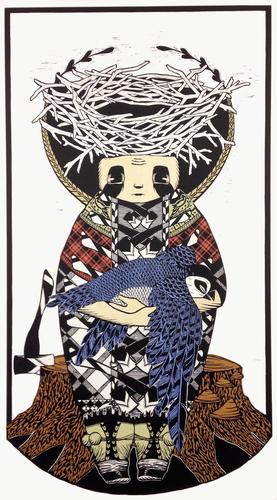Next stop over Austin, Texas. Since 2018, during my first visitation to the Austin Book Arts Center, the key members have been very welcoming and invited me to join in any event happening throughout while staying in the city.
Approaching Austin, I instantly communicated with Olivia Primanis and Mary Baughman, letting them know of my plans. A prompt response was received with pertinent information on the Third Thursday Series of ABAC for the month of November. Olivia Primanis presented “How will I bind this artists’ book? I couldn’t miss this guest artist talk!
© 2019 Louise Levergneux. The cloth corner of the Austin Book Arts Center in Austin, Texas.
© 2019 Louise Levergneux. The Austin Book Arts Center is filled with interesting equipment..
The email naturally included a kind invitation for me to participate in the conversation and present my own artists’ books. I happily brought two books and took part in the discussion. The overall session was a hands-on exploration of a variety of materials and structures that were used through the centuries and how they affect how a book handles. Carefully choosing a particular structure for your specific project remains a key element for success of the « raison d’être » of the artists’ book.
This was a terrific evening enjoying the camaraderie of people who appreciate bindings and artists’ books. An incredibly popular session provided me the opportunity to encounter other members of the ABAC.
© 2019 Louise Levergneux. (from left) Bob Bryant enjoys the enviable reputation of being a treasure for the center, Bob collects old books, and in 2017 decided to take classes, which permits him to repair his own collection; Mary Baughman, Olivia Primanis, Linda Anderson; Margaret Tenney is documenting the event and is as a board member; Sigrid Nama and Christopher Hynes an artist who creates assemblage art and paintings.
© 2019 Louise Levergneux. One of Olivia Primanis' great pleasures is experiencing the way each binding structure effects how a book’s “mechanics’ work!”; Linda Anderson instructs book-arts classes for teachers at ABAC; Kathryn Cooksey Pew and Sigrid Nama.
© 2019 Louise Levergneux. Linda Anderson, Christopher Hynes, Mathew De La Cruz, Beatrice Baldwin, Suzan O’Connor, and Mary Dines.
© 2019 Louise Levergneux. Exploration of a remarkable variety of structures.
© 2019 Margaret Tenney. Myself, Bob Bryant, and Christopher Hynes’ artists' book “Threads of Life: Of Birds and Clouds.”
© 2019 Louise Levergneux. Kathryn Cooksey Pew, Sigrid Nama, Christopher Hynes, and Beatrice Baldwin. The accordion structure in the forefront is Christopher Hynes’ artist's book which was part of Olivia’s question for the talk, “which binding will create physical qualities that flow with the narrative of “Threads of Life: Of Birds and Clouds.”
© 2019 Margaret Tenney. Alan Stearman, myself, and Bob Bryant; Laura Agnew a wonderful volunteer; Olivia Primanis, Linda Anderson, Kathryn Cooksey Pew, Sigrid Nama, Beatrice Baldwin, and Suzan O’Connor.
© 2019 Margaret Tenney. (from center to left around the table back to the right) Kathryn Cooksey Pew, Sigrid Nama, Christopher Hynes, Beatrice Baldwin, and Barbara Brown; Mary Baughman a board member; Lena Rogy, trained in book binding in Germany is currently teaching workshops at ABAC; Andrew; Amanda Stevenson, Executive Director of ABAC; Alan Stearman an engineer who followed a couple of workshops, then helped to repair or improve equipment at ABAC; myself and Bob Bryant.
© 2019 Margaret Tenney. The talk brought me back to my books and their structure. My turn to talk about my books and the reason for structure; Mathew De La Cruz in the background.
© 2019 Louise Levergneux. Alan walking by some of the equipment in the studio. He has devised a solution for the board shear of ABAC. The replacement counter weight was unbalanced and the board shear was a bit unsafe to use. Alan drilled into the replacement counter weight to attach a threaded rod. He found a weight for a telescope that fits the threaded rod. This current rod allows the new weight to be placed where it balances the blade of the board shear. Alan equally found magnets that can be turned on and off. These magnets are used to secure the "fence" on the board shear.
If any of you are in the Austin area, visiting the Austin Book Arts Center it is worth the effort to properly engage with creative people experienced in book arts. If you have time, join a workshop in letterpress printing, bookbinding, papermaking, typography, or book history.



















